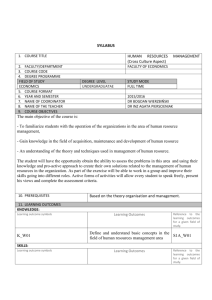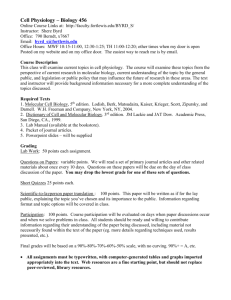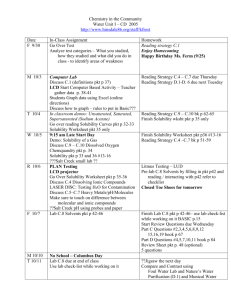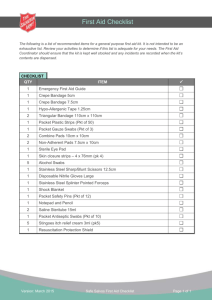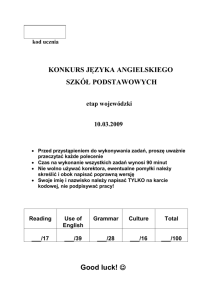Mitigating Climate Impacts from Transportation: Opportunities and Challenges University of Warwick
advertisement
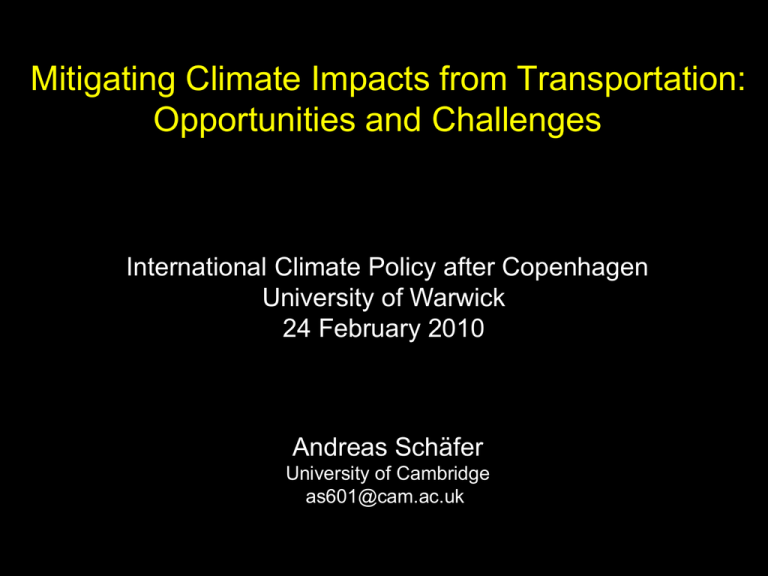
Mitigating Climate Impacts from Transportation: Opportunities and Challenges International Climate Policy after Copenhagen University of Warwick 24 February 2010 Andreas Schäfer University of Cambridge as601@cam.ac.uk A Century of Growth 9 600 500 8 All other Countries United States 400 Other industrialized countries 7 300 200 Aircraft revenue passenger-km, billion 700 Use of petroleum products, billion bbl World LDV fleet, million vehicles 800 6 U.S. 100 5 0 1900 1920 1940 1960 1980 2000 4,500 4,000 3,500 All other Countries 3,000 Electricity generation 2,500 Other industrialized countries 2,000 Industry 1,500 1,000 2020 Residential Commercial 500 0 1900 1920 1940 1960 U.S. 2000 1980 4 3 Transport 2 1 0 1900 1920 1940 1960 1980 2000 2020 2020 Oil Dependence and related Concerns • Climate Change – Burning 1 kg of oil forms nearly 3.2 kg of CO2 Imports (% Consumption) – Concentration of global reserves in Middle Eastern economies – Oil price volatility, “oil weapon”, use of oil revenues, etc. Oil Imports 90 80 EU-22 70 60 50 US 40 30 20 10 0 1965 1970 1975 1980 1985 1990 1995 2000 2005 2010 120 Crude Oil Price 100 $(2007)/bbl • Oil products represent 94% of all transp. fuels • Oil import dependence 100 80 60 40 20 0 1860 1880 1900 1920 1940 1960 1980 2000 2020 Data source: BP Statistical Review of World Energy June 2008 Rising Atmospheric CO2 Concentration Atmospheric CO2 concentration, ppm 420 Monthly mean atmospheric CO2 concentration measured at Mauna Loa Observatory, Hawaii 400 380 360 340 320 300 Data source: Tans P., NOAA/ESRL (www.esrl.noaa.gov/gmd/ccgg/trends/) 280 1950 1960 1970 1980 1990 2000 2010 2020 Stern Review (2006) Structural Change in the Energy System Share in Final Energy, % Share in Final Energy, % (Time series data from 1971 – 1998) 100 90 Residential Agriculture 80 70 60 50 Industrialized Regions: North America Pacific OECD Western Europe 40 30 Reforming Economies: Eastern Europe Former Soviet Union 20 10 0 100 90 Industry Services 80 70 60 50 40 Developing Regions: Centrally Planned Asia Latin Ameria Middle East & North Africa Other Pacific Asia South Asia Sub-Saharan Africa Transportation 30 20 10 0 Other Services 0 5,000 10,000 15,000 20,000 25,000 30,00035,000 GDP/cap, US$(2000) 0 5,000 10,000 15,000 20,000 25,000 30,00035,000 GDP/cap, US$(2000) GHG Emissions: Identity GGE = GGE E A E PKT PKT Each RHS-factor tends to increase! Determinants of Travel Demand: TTB Average daily travel time, h/cap 4.0 Selected Data Points: 1 Tanzania Villages (1986) 2 Ghana Villages (1988) 3 Palestine (1999/2000) 4 Romania (1991) 5 Warsaw (1993) 6 Sao Paulo (2002) 7 South Africa (2001) 3.5 3.0 2.5 8 South Korea (1995) 9 Germany (1982) 10 Singapore (1991) 11 Spain (2002/03) 12 Paris (1991) 13 Tokyo (1990) 14 Finland (2000) 15 Japan (2001) 16 France (2000) 17 Paris (2001) 18 Switzerland (1989) 19 Great Britain (2004) 20 Norway (2000) 21 United States (2001) 2.0 1.5 5 1 2 1.0 4 10 6 7 8 9 12 17 15 21 18 11 13 20 14 3 16 19 Villages Cities Countries 0.5 0 0 5,000 10,000 15,000 20,000 25,000 30,000 35,000 GDP/cap, $ Travel Time Budget: Stability Time-use surveys, 1965/66 and early 2000s Time dedicated to major activities, h/cap/d 10 9 Sleep ( ) 8 7 Leisure & Study ( ) 6 5 Household & Family Care ( 4 ) 3 Personal Care & Meals ( ) 2 Travel ( 1 0 0 ) 1 2 3 4 Work time, h/cap/d 5 6 7 Share of GDP dedicated to travel, % Determinants of Travel Demand: TMB 25 Data Points: U.S. (1909, 1914, 1919, 1924, 1929, 1950 - 2005) Japan (1963 - 2005) France (1959, 1962-2005) Germany (1970-2004) Italy (1963 - 2005) UK (1963-2005) Bulgaria (1997 - 2005) Hungary (1994, 1996 - 2005) 20 15 1 2 3 4 Poland (1995, 2000 - 2005) Romania (2000 - 2005) Western Europe (1973 - 2005) Eastern Europe (2000 - 2005) Sri Lanka (2002) Turkey (1994) South Africa (2000) Mexico (2000) 10 4 2 3 5 1 0 0 100 400 200 300 500 600 Motorization level, LDV/1000 capita 700 800 Determinants of Travel Demand: Travel Costs Travel Costs to consumer, $(2000)/pkm 0.25 United States 0.20 Aircraft Light-duty vehicles 0.15 All modes 0.10 Low-speed public transport 0.05 0 1950 1960 1970 1980 1990 2000 2010 Growth in Global Mobility (1950-2005) 1,000,000 Sub-Saharan Africa Latin America Middle East & North Africa Other Pacific Asia North America 100,000 Pacific OECD PKT/cap Western Europe Eastern Europe Former Soviet Union South Asia 10,000 Centrally Planned Asia World 1,000 100 100 1,000 10,000 GDP/cap, US$(2000) 100,000 1,000,000 High-speed modes, %PKT Light-duty vehicles, %PKT Low-speed public transport, %PKT Shift from Slow to Fast (1950-2005) 100 90 80 70 60 50 40 30 20 10 0 100 100 90 80 70 60 50 40 30 20 10 0 100 100 90 80 70 60 50 40 30 20 10 0 100 1,000 10,000 PKT/cap 100,000 1,000,000 Industrialized Regions: North America Pacific OECD Western Europe Reforming Economies: Eastern Europe Former Soviet Union Developing Regions: Centrally Planned Asia Latin Ameria Middle East & North Africa Other Pacific Asia South Asia Sub-Saharan Africa 1,000 10,000 PKT/cap 100,000 1,000,000 1,000 10,000 PKT/cap 100,000 1,000,000 Shift from Slow to Fast (1950-2050) (Travel Time Budget = 1.2 h/cap/d) 100 Industrialized Regions 195020052050 Developing Reforming Regions Economies 195020052050 195020052050 World 195020052050 60 40 20 SR E EP S-B PA 1 -R ef SR E EP S-B PA 1 -R ef SR E EP S-B PA 1 -R ef 0 High-Speed Transportation Low-Speed Public Transport Light-Duty Vehicles SR E EP S-B PA 1 -R ef Mode Share, % PKT 80 Trends in Consumer Behavior toward ... • higher travel demand (PKT) • larger and more powerful vehicles (higher E/PKT) • declining price elasticity of travel due to – Increasing dependence on automobiles and high-speed transportation – Rising income, lack of large-scale substitutes for oil products Po we r, kW Si ze ,L Fu el Co l/1 nsu 00 m km pti on , En gi ne En gi ne we ig ht ,k g % Change in Vehicle Attributes 1983 Camry Cu rb Example for higher E/PKT: Upgrades of Toyota Camry 80 70 60 2007 Camry 50 40 30 20 10 0 E/PKT: Trends in Energy Intensity 4.0 Energy Intensity, MJ/pkm 3.5 3.0 Shift toward more powerful vehicles Structural changes in auto travel Higher frequency air services Flattening stage length distribution Others US 2.5 2.0 1.5 1.0 Great Britain Germany France Switzerland Japan Penetration of BATs in aviation Rising PAX load factors Others 0.5 0.0 1950 1960 1970 1980 1990 2000 2010 2020 2030 2040 2050 Opportunities for Reducing E/PKT … Road Vehicles: E VKT = 1 ηPropulsion System (A + D + R) Q SFC PAX V (L/D) WF W0 ln W0-WF Jet Aircraft: E PKT = … and Constraints • Engineering trade-offs – Occupant safety vs. automobile weight, etc. – Larger aircraft wingspan (to increase L/D) vs. increase in aircraft weight, etc. • Consumer acceptance – Battery-electric vehicles vs. range, etc. – Turboprop aircraft engines vs. passenger comfort, etc. • Development costs of new (road and air) vehicles several billion dollars → existing, proven designs – Evolutionary process implies that many fuel-saving technologies have long history Time Constants: Technology 95 years Racing version of the front wheel driven, petrol-electric Lohner "Porsche“ in 1900. http://www.hybrid-vehicle.org/hybrid-vehicle-porsche.html 73 years 100+ years? Hugo Junkers' 1924 design for a giant flying wing. The wing was to accommodate 26 cabins for 100 passengers, carry a crew of 10, and have enough fuel for 10 hours of flight. http://www.century-of-flight.net/Aviation%20history/flying%20wings/Early%20Flying%20Wings.htm Time Constants: Technology, contd. U.S. Automobiles World Aircraft 100 100 90 90 MY 2000 MY 1990 80 MY 1990 % Aircraft Still In Fleet % Vehicle Still In Fleet 80 70 60 50 40 30 MY 1966 20 70 60 MY 1980 50 40 30 MY 1970 20 10 MY 1960 10 0 0 0 5 10 15 20 25 30 Vehicle Age, years Source: Transportation Energy Databook, Editions 13, 20 0 10 20 30 Aircraft Age, years Source: Morrell P., L. Dray, 2009 40 50 60 Opportunities for Reducing E/PKT: Summary (while maintaining current performance characteristics!) • By mid’ 2020s E/PKT reduction potential ≈ 30-50% (for the average new LDV or aircraft in early 2000) • By midcentury Natural fleet turnover would translate these reductions to the vehicle fleet Automobile Cost Curve: U.S. Retail Price Increase,$(2000) 6000 5000 Hybrid 4000 3000 Alum 2000 1000 PowTrn2 ZeroCost BLV PowTrn1 LowCost 0 0 1 2 3 4 5 6 7 Fuel Consumption, L/100km 8 9 10 95Fleet 11 Introduction of Technology (U.S.) Gaseoline Retail Price, US$/L Reference Case Kyoto+ Case Kyoto Case 3.0 2.5 2.0 1.5 1.0 0.5 0 25 Energy Use, EJ 20 Light-duty vehicles Light-duty vehicles 15 All other modes 10 Light-duty vehicles All other modes All other modes 5 MARKAL EPPA MARKAL EPPA MARKAL EPPA 0 5.0 Passenger-km, trillion 4.5 3.5 3.0 Reference case automobile pkm Reference case automobile pkm Total fleet 4.0 Demand 95 Flt Loss 95 Flt Demand loss Total fleet Total fleet 95 Flt 2.5 PowTrn1 2.0 1.5 1.0 LoCost ZeroCost LoCost 0.5 0 1995 2000 PowTrn2 PowTrn1 ZeroCost ZeroCost 2005 2010 2015 2020 2025 2030 1995 2000 2005 2010 2015 2020 2025 2030 1995 2000 2005 2010 → Importance of incremental improvements Alum 2015 2020 2025 2030 Opportunities: Alternative Fuels • • • • • Weight/volume characteristics Compatibility to existing fuel infrastructure Convenience of fuel handling / storage Fuel costs / volatility Energy independence / security of supply / location and size of resources • Environmental impact (→ Lifecycle analysis) Transport System Scale No. additional 1GWel nuclear reactors to satisfy 2005 US LDV energy demand via water electrolysis-based H2 Technical Potential for Reducing GHG Emissions Lifecycle GHG emissions, MtCO2-eq 30,000 Constant Technology World 25,000 Maximum Technology 20,000 15,000 10,000 5,000 0 Lifecycle GHG emissions, MtCO2-eq 5,000 Fuel & vehicle cycle High-speed transport Low-speed public transport Light-duty vehicles United States 4,000 3,000 2,000 1,000 0 EPPARef 1950 2005 SRESB1 EPPARef 2050 SRESB1 What does this mean? • Large technology opportunities • Challenges (consumer behavior, costs for low-GHG emission technology, transport system scale, time constants, others) • Policy measures to rebalance consumer preferences (market-based measures, regulatory measures, R&D) • Travel demand continues to grow, also in a climateconstrained world The Choices Ahead • Government – Type of policy measure to change consumer and industry choice of new vehicle attributes (market-based / regulation / both) – Single policy approach vs. some portfolio of measures – Economy wide vs. passenger transport only – R&D investments • Industry action depends upon government policy, BUT … – GHG emission problem will not fade away (see structural change in energy use) – R&D investments (also) into reducing fuel consumption • Satisfies climate change and oil dependence • Importance of improving mainstream technology • And GHG mitigation ultimately depends on us! www.TransportAndClimate.com
